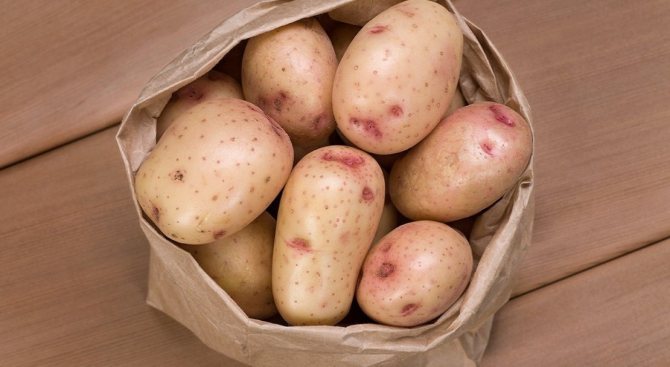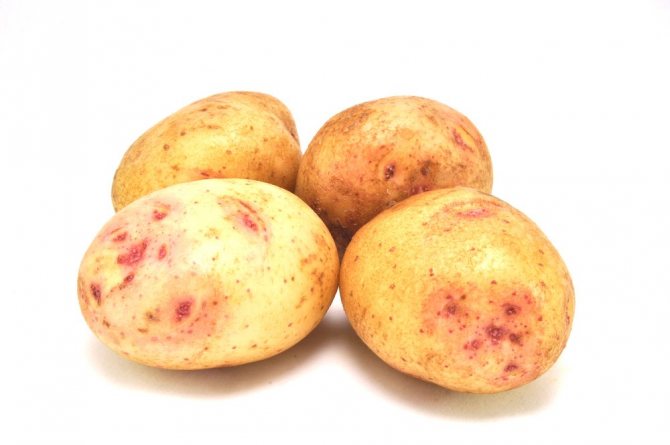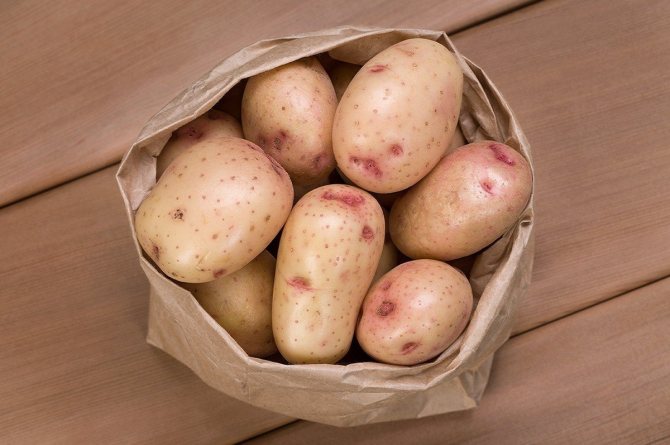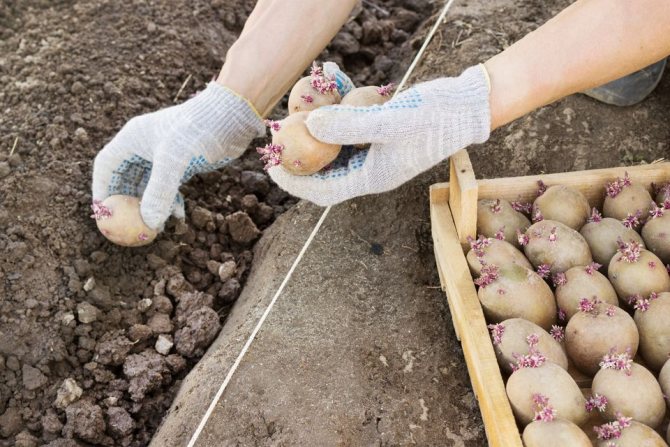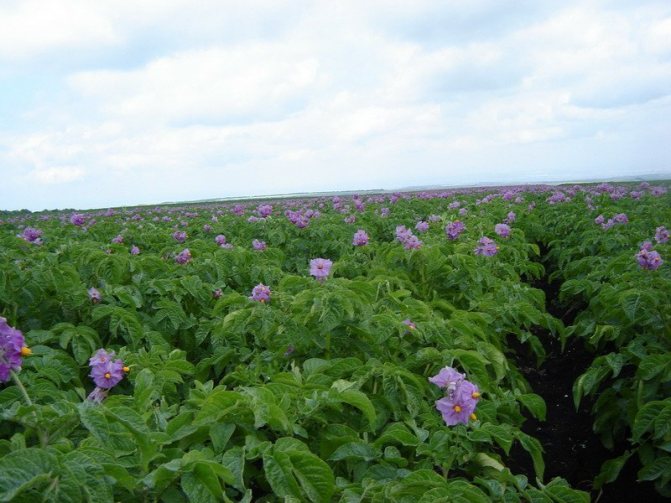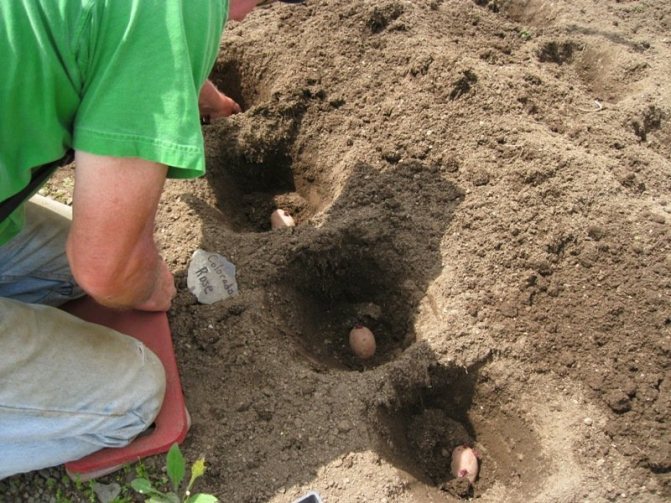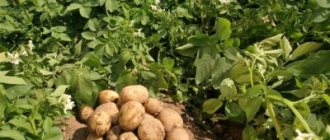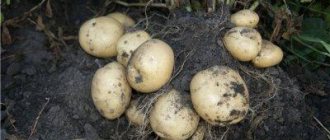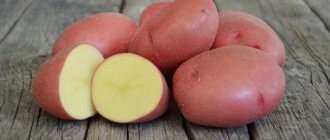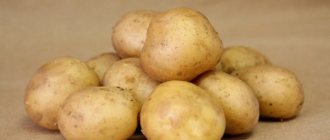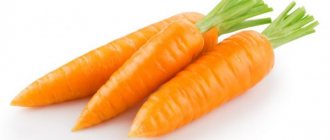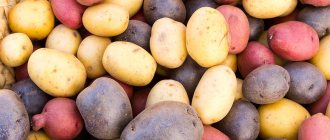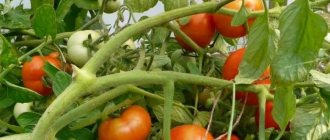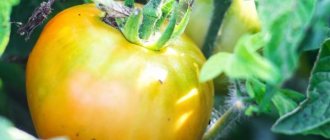Description of the variety
| Variety name | Sineglazka |
| general characteristics | amateur variety, high-yielding with good taste, but poor keeping quality |
| Ripening period | 65-80 days |
| Starch content | 15% |
| Mass of marketable tubers | 70-130 gr |
| The number of tubers in the bush | 8-12 |
| Yield | up to 500 c / ha |
| Consumer qualities | great taste, suitable for all dishes |
| Keeping quality | when storing large quantities, about 75% rot |
| Peel color | cream |
| Pulp color | white |
| Preferred growing regions | The variety is zoned for central Russia |
| Disease resistance | moderately resistant to all nightshade diseases |
| Growing features | standard agricultural technology |
| Originator | bred in the 50s of the last century by S. Domin at the Institute of Starch Products; recognized as unpromising |
"Sineglazka" - mid-season variety with early tuberization... Ideal for private household farms, almost never grown in industrial volumes. Read here how to grow early potatoes correctly.
Root description:
- tubers are large, weighing from 150 to 200 g;
- oval shape, slightly flattened;
- the peel is pink-gray, with a bluish tinge;
- eyes are superficial, few in number, dark blue;
- the flesh on the cut is white;
- the starch content is average, up to 15.5%;
- high protein content, mineral salts, vitamins of group B.
In the table below you will find data on the starch content of different varieties of potatoes:
| Variety name | Starch content |
| Sineglazka | 15% |
| Manifesto | 11-15% |
| Tiras | 10-15% |
| Elizabeth | 13-14% |
| Vega | 10-16% |
| Lugovskoy | 12-19% |
| Romano | 14-17% |
| Santa | 10-14% |
| Tuleyevsky | 14-16% |
| Gypsy | 12-14% |
| Story | 14-17% |
Testimonials
Elena, 52 years old
“For 20 years now I have been planting Sineglazka together with the main potatoes. I love to bake it or stew it. For a long time I could not find a suitable remedy for the Colorado potato beetles, since I do not like chemicals, and I found it. I recommend pouring 10-15 dill seeds into each hole to a depth of 15-17 cm. They will not sprout because of the large distance to the soil surface, but thanks to them, you can forget about pests for the whole season ”.
Vera, 49 years old
“Sineglazka began to grow recently and noticed that every year the harvest is different, sometimes there are a lot of large tubers, sometimes quite a bit of 'trifles'. Then I realized that a bad harvest is obtained due to the planting of Sineglazka analogues, since new hybrids appear every year. If possible, it is better to find the original of this variety. "
Sineglazka is a favorite type of potato gardeners, which they have been growing for decades. To grow a good harvest, study the features of this variety, the rules for caring for it, collecting and storing it.
Photo
Now that you have already got some ideas about the Sineglazka potato variety, characteristics of its appearance, root crop, let's move on to the photographs:
Storage rules
At the first stage, the potatoes are laid out in boxes and sent to a dark, warm room with a temperature of +15 C ... + 18 C degrees. Within 3-4 weeks, the tubers gain flavor, the texture improves and the skin becomes denser. After that, the potatoes are sent for permanent storage, with an average temperature of +2 C degrees and a humidity level of 85-90%.The most important condition for successful storage is ventilation.
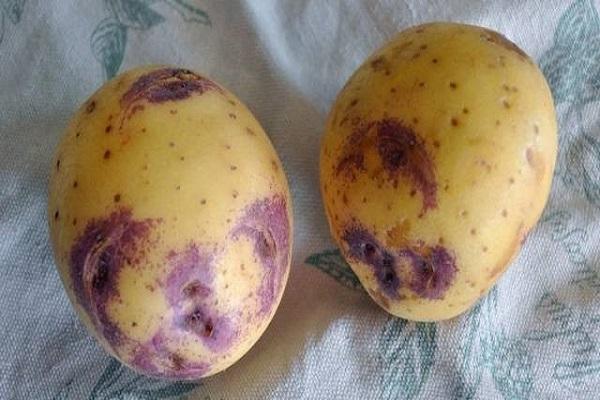
Breeding and growing regions
The variety is zoned for central Russia, it is successfully grown in other regions. The yield is high, up to 500 kg. per hundred square meters. The quality of the crop depends on the planting material, weather conditions and soil nutrition.
You can compare the yield of this variety with others by referring to the table below:
| Variety name | Yield |
| Sineglazka | up to 500 c / ha |
| Kubanka | up to 220 c / ha |
| Felox | 550-600 c / ha |
| Pretty boy | 170-280 c / ha |
| Red Scarlett | up to 400 c / ha |
| Borovichok | 200-250 c / ha |
| Bullfinch | 180-270 c / ha |
| Kamensky | 500-550 c / ha |
| Colomba | 220-420 c / ha |
| Spring | 270-380 c / ha |
The Sineglazka potato bush is large, powerful, with strong stems and a developed root system. Abundant formation of green mass. Leaves are medium in size, dark green. The flowers are light blue, small.
Potatoes are distinguished by early tuber formation and extended growing season. The first crop can be harvested in June, the end of harvest is the end of September. The variety prefers light sandy soil with neutral acidity; in heavy, poor soil, yield decreases.
Watering is moderate, no more than 5 times per season. "Sineglazka" prefers nutritious soil, root top dressing with mineral complexes or organic fertilizers is required. Read about when and how to make top dressing and how to do it correctly when planting potatoes in separate articles on our website.
The variety is resistant to typical diseases: potato cancer, late blight, scab, nematode, viral infections. Strong tubers are not damaged when dug up. Small volumes are well stored, but the variety is not suitable for industrial cultivation.
For information on the conditions in which to store potatoes in winter, which place to choose for this and what time frames need to be observed, read the detailed materials on our website.
Sineglazka is loved by gardeners for its excellent taste. The potatoes are ideal for boiling, baking and mashed potatoes, they are crumbly, very tender, with a pleasant rich taste. Boiled tubers have a beautiful creamy white color. Potatoes are easy to digest and can be recommended for baby or diet food.
We have prepared several useful articles for you on how to properly store peeled potatoes and whether you can keep the benefits of this product in the refrigerator.
Care
Watering. Water stagnation should not be allowed, and the lack of moisture also affects the harvest negatively. Mandatory watering of plants is necessary during the following periods:
- after the emergence of sprouts;
- during budding;
- after flowering ended.
If there is a severe drought and the soil begins to crack, and the potato bushes look drooping, watering is imperative. For normal moistening of potato plantings, 40 liters of water per 1 m² are used.
Hilling and loosening. Sineglazka potatoes are spud twice during growth. The first hilling is carried out when the tops have grown by 15-20 cm. In this case, the soil is raked from the rows to the stem of the bush. The next hilling is performed in two weeks. It is better to loosen the soil after rain or watering. And so that moisture does not evaporate so quickly, the aisles are mulched with hay, straw or fresh grass.
Origin
Sineglazka potato variety - hybrid of several forms of cultivated potatoes with wild... Bred by breeder S. Demin in the late 1940s, registered at the Institute of Starch Products under the number 15555.
The hybrid was tested at several experimental stations, was highly appreciated by specialists and a recommendation for growing on personal subsidiary plots. Tests on industrial cultivation of Sineglazka were less successful. Large volumes of harvested potatoes were poorly stored, tubers quickly lost their presentation.
Sineglazka: beloved because it is delicious
Wonderful yielding potatoes with bluish eyes are difficult to find today. Gradually, it is being replaced by more and more new varieties. But those who still manage to buy seed will not regret it at all. Many speak of Sineglazka as the most delicious potato of all.
Breeding work on the creation of this variety was carried out in the post-war years by the Institute of Starch Products under the USSR Ministry specifically for individual cultivation. It has never been cultivated on an industrial scale. The variety turned out to be so successful that for reproduction it was distributed free of charge to villagers and summer residents in the districts of the Smolensk region. People liked it and spread with great speed throughout the territory of the entire former Soviet Union.
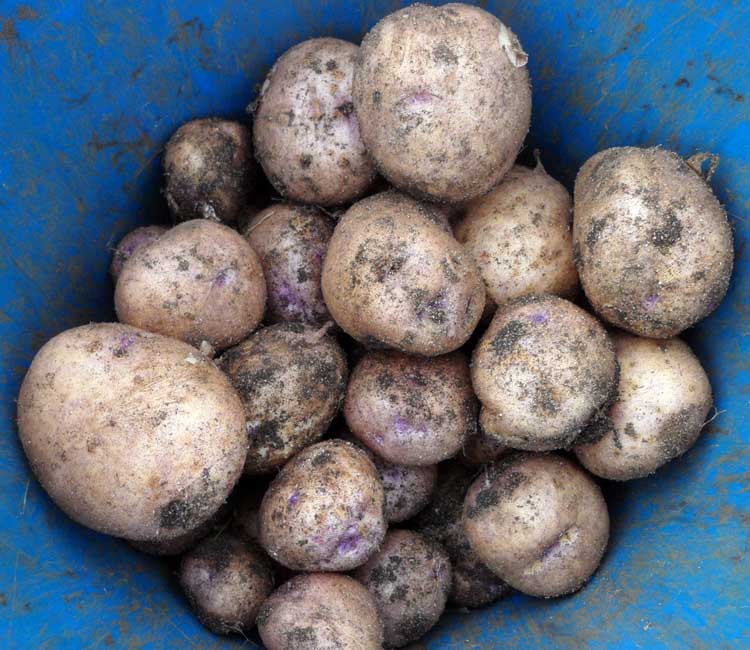

Sineglazka is the most popular variety in the Soviet Union
Sineglazka gained popularity among gardeners due to its unpretentious care and consistently high yields.
Few people know that the real name of the variety is Hannibal. It is named so in honor of the famous great-grandfather A.S. Pushkin, who at one time was fond of breeding and was one of the first to experiment with potatoes.
Advantages and disadvantages
Among the main advantages of the variety are:
- high taste of root crops;
- wide culinary possibilities (cooking, stewing, baking, mashed potatoes are possible);
- resistance to major diseases;
- beautiful appearance of root crops;
- thin peel, few eyes.
Among the disadvantages of the variety are:
- the possibility of degeneration of the planting material;
- large volumes of harvested potatoes poorly stored;
- tubers can be damaged by wireworm.
Pests
Potato moth. The clutch of eggs of this insect can be found on the inner side of the leaf next to the petiole. Soon, caterpillars appear from them, which feed on leaves and roots located closer to the surface of the earth. Damaged potatoes start to rot. Potato moths can be caught with pheromone traps. If the caterpillars have already appeared, the plants are treated with Cytocor or Spark. Bitoxibacillin is used two weeks before harvesting.
Wireworm. This is the name of the larva of the click beetle, which gnaws through the passages in the potatoes. Damaged crops are not stored. When landing in the hole, add Bazudin or Pochin. The site is dug up in late autumn so that the larvae are on the surface and die from the cold. And also the presence of weeds, especially wheatgrass, should not be allowed. Marigolds are planted next to the potatoes, which scare away the clickers with their smell.
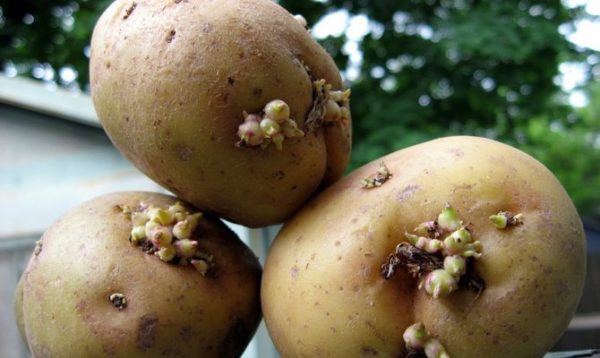

Colorado beetle. The larvae of this insect are capable of destroying plantings in a matter of days. In order not to lose the harvest, the plants are sprayed with the preparations "Masterpiece" or "Prestige", "Batsikol", "Dendrobacillin".
Good to know! If there is high humidity in the cellar, then beets are laid out on top of the potatoes, since they are able to absorb all the excess moisture.
Features of the
"Sineglazka" refers to the old varieties that have a number of features. In a favorable year (warm weather, sufficient, but not excessive amount of rain, minimal number of pests), potatoes show high yields, tubers are large, even, undamaged. Deterioration of weather conditions greatly reduces yield, tubers become smaller.
To avoid such swings, it is important to buy quality, renewed seed potatoes that are free from viruses. It is not recommended to use only self-grown tubers for sowing; the variety must be completely renewed every few years.
Good results are obtained by growing potatoes from seeds., this makes it possible to update the planting material without additional costs for its purchase.Potatoes are responsive to feeding. Mulching the beds will not hurt either.
Fertilize plants immediately after watering, 3-4 times per season. For feeding, rotted manure or diluted bird droppings are used. Organics can be alternated with a mineral complex, including ammonium nitrate, superphosphate or ammonium sulfate.
The use of nitrogen-containing preparations is undesirable. They cause rapid growth of potato tops with simultaneous shrinking of tubers.
In addition to fertilizers, a variety of products and preparations are used when growing potatoes. There are many debates about their benefits. We bring to your attention detailed articles on how and for what herbicides, fungicides and insecticides are used.
The crop can be harvested from early summer to September, but the best quality tubers are gaining by August. After digging, the tubers are dried for at least 3 hours. In cloudy weather, drying is carried out in a shelter or under a canopy.
The larger the crop, the more thoroughly the tubers are dried. The variety is not very good keeping quality; potatoes need a spacious dry cellar. The tubers are stacked in boxes. Potatoes must be sorted regularly, discarding rotten or infected tubers.
Planting potatoes
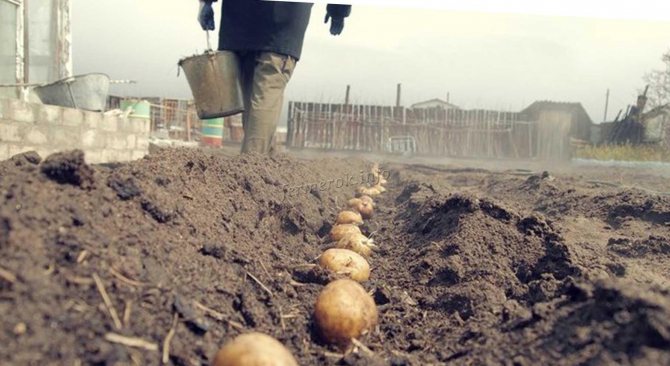

Photo of planting potatoes
Planting time for potatoes may differ depending on the region, so most gardeners are guided by the lunar calendar or the weather. An old popular belief says that potatoes should be planted when birch leaves are about the size of a coin.
Important!
Important!
To make the potatoes less sick, it is recommended to sprinkle the sprouted tubers with ash before planting. And so that the wireworm does not encroach on the crop, a pinch of dry mustard is poured into the hole with potatoes.
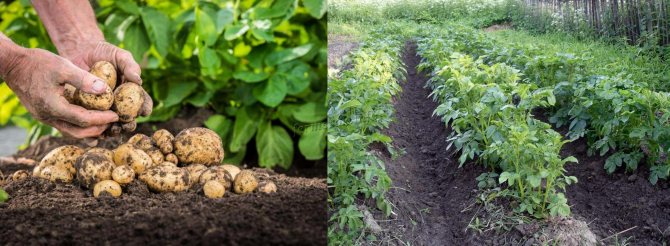

Planting and harvesting potatoes photo
Sprouted tubers are planted using any method convenient for the gardener. These are usually simple rows, but trenches, bags, barrels, or any other method of growing potatoes can also be used. The preferred soil is sandy or sandy loam - that is, loose, soft, convenient for the growth of tubers. The distance between the individual rows should be at least 65 cm for comfortable walking. And between the seedlings, 40-60 cm of free space is observed. Planting depth 5-10 cm, depending on the size of the tuber.

